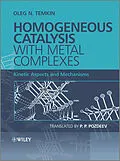Homogeneous catalysis by soluble metal complexes has gained
considerable attention due to its unique applications and features
such as high activity and selectivity. Catalysis of this type has
demonstrated impressive achievements in synthetic organic chemistry
and commercial chemical technology.
Homogeneous Catalysis with Metal Complexes: Kinetic Aspects
and Mechanisms presents a comprehensive summary of the results
obtained over the last sixty years in the field of the kinetics and
mechanisms of organic and inorganic reactions catalyzed with metal
complexes.
Topics covered include:
* Specific features of catalytic reaction kinetics in the
presence of various mono- and polynuclear metal complexes and
nanoclusters
* Multi-route mechanisms and the methods of their identification,
as well as approaches to the kinetics of polyfunctional catalytic
systems
* Principles and features of the dynamic behavior of nonlinear
kinetic models
* The potential, achievements, and limitations of applying the
kinetic approach to the identification of complex reaction
mechanisms
* The development of a rational strategy for designing kinetic
models
* The kinetic models and mechanisms of many homogeneous catalytic
processes employed in synthetic and commercial chemistry
Written for specialists in the field of kinetics and catalysis,
this book is also relevant for post-graduates engaged in the
study
Autorentext
Professor Oleg Temkin is a well known specialist in the field of Chemical Kinetics, Catalysis with Metal Complexes, Alkynes Chemistry and Mathematical Chemistry. He is a professor of M.V. Lomonosov Moscow State University of Fine Chemical Technologies.
Professor Temkin is a co-author of 3 monographs and 2 Chapters in monographs, as well as more than 360 scientific publications including reviews, in such journals as J. Mol. Catal., Organometallics, J. Phys. Chem., J. Chem. Soc. Chem. Commun., Inorg. Chim. Acta,? Langmuir, J. Chem.Ed., React. Kinet. Catal. Lett., J. Chem. Inf. Comput. Sci.,? Mathem.Chem., J. Comput. Chem., J. Mol. Structure(Theochem) as well as in Russian Journals.
Zusammenfassung
Homogeneous catalysis by soluble metal complexes has gained considerable attention due to its unique applications and features such as high activity and selectivity. Catalysis of this type has demonstrated impressive achievements in synthetic organic chemistry and commercial chemical technology.
Homogeneous Catalysis with Metal Complexes: Kinetic Aspects and Mechanisms presents a comprehensive summary of the results obtained over the last sixty years in the field of the kinetics and mechanisms of organic and inorganic reactions catalyzed with metal complexes.
Topics covered include:
- Specific features of catalytic reaction kinetics in the presence of various mono- and polynuclear metal complexes and nanoclusters
- Multi-route mechanisms and the methods of their identification, as well as approaches to the kinetics of polyfunctional catalytic systems
- Principles and features of the dynamic behavior of nonlinear kinetic models
- The potential, achievements, and limitations of applying the kinetic approach to the identification of complex reaction mechanisms
- The development of a rational strategy for designing kinetic models
- The kinetic models and mechanisms of many homogeneous catalytic processes employed in synthetic and commercial chemistry
Written for specialists in the field of kinetics and catalysis, this book is also relevant for post-graduates engaged in the study
Inhalt
Notations and Abbreviations xi
Preface to English Edition xvii
Preface xix
Acknowledgments xxi
About the Author xxiii
Introduction 1
1 State-of-the-Art in the Theory of Kinetics of Complex Reactions 21
1.1 Main concepts of the HoriutiTemkin theory of steady-state reactions 21
1.1.1 Reaction mechanism: Stoichiometry and routes 22
1.1.2 Kinetics: Reaction rates with respect to substances and over routes 32
1.1.3 Kinetic polynomial 42
1.1.4 Determining the number of independent parameters in a kinetic model. The problem of identifiability of parameters 44
1.2 Quasi-steady-state and quasi-equilibrium approximations in chemical kinetics 47
1.2.1 Theoretical criteria of quasi-steady-state intermediate concentrations and quasi-equilibrium steps 49
1.2.2 Experimental criteria of applicability of quasi-steady-state approximation in various systems 60
1.3 Methods of graph theory in chemical kinetics and in theory of complex reaction mechanisms 62
1.3.1 Linear mechanisms 62
1.3.2 Nonlinear mechanisms 71
1.3.3 Other fields of application of kinetic and bipartite graphs in chemical kinetics and in theory of complex reaction mechanisms 76
1.4 Elementary steps Selection rules 79
1.4.1 Main postulates, laws, and principles 79
1.4.2 Energy selection rules for elementary steps 88
1.4.3 Quantum-chemical selection rules for elementary steps 92
1.4.4 Topological selection rules for elementary steps 108
References 113
2 Complexity Functions of Catalysts and Reactants in Reactions Involving Metal Complexes 121
2.1 Mononuclear metal complexes 122
2.1.1 Complexity functions: variants I and II 134
2.1.2 Complexity functions: variants III and IV 149
2.1.3 General problems and recommendations 165
2.2 Polynuclear complexes in homogeneous catalytic and noncatalytic reactions 167
2.2.1 Systems with formation of associates 168
2.2.2 Systems with mononuclear and polynuclear complexes of various types 182
2.3 Catalysis with polynuclear copper(I) halide complexes in superconcentrated solutions 193
2.3.1 Copper(I) chloride complexes in solution and in crystalline state 194
2.3.2 Kinetics of catalytic reactions of alkynes in concentrated NH4ClCuCl aqueous solutions at constant complexity functions FCu and FCl 203
2.3.3 Determination of compositions of catalytically active copper(I) complexes in various reactions 210
2.3.4 Studying and complexes of copper(I) with alkynes in crystalline state and in solution 216
2.3.5 Mechanisms of acetylene dimerization and hydrocyanation reactions. Crystallochemical aspects 227
References 231
3 Multi-Route Mechanisms in Reactions Involving Metal Complexes 239
3.1 Factors accounting for the appearance and kinetic features of multi-route mechanisms 239
3.2 Analysis of multi-route reaction kinetics 246
3.3 Conjugation nodes and artificial multi-route character 271
3.4 Conjugate processes 304
3.4.1 Classical approach 305
3.4.2 Kinetic and thermodynamic conjugation in consecutive reactions 309
3.4.3 Conjugation in chain reactions 317
3.4.4 Conclusions 323
References 328
4 Polyfunctional Catalytic Systems 335
4.1 Oxidation reactions of organic and inorganic compounds 341
4.1.1 Oxidation of alkenes 341
4.1.2 Oxidation of 1,3-dienes 356
4.1.3 Oxidation of alkynes and arenes 366
4.1.4 Oxidation of inorganic compounds 369
4.2 Reactions of chlorination and oxidative chlorination of organic compounds 372
4.2.1 Oxidative chlorination of alkynes 372
4.2.2 Oxidative chlorination of 1,3-dienes 384
4.2.3 Polyfunctional catalytic systems in chlorination reactions 386
4.3 Oxidative carbonylation of organic compounds 389
4.3.1 Oxi...
